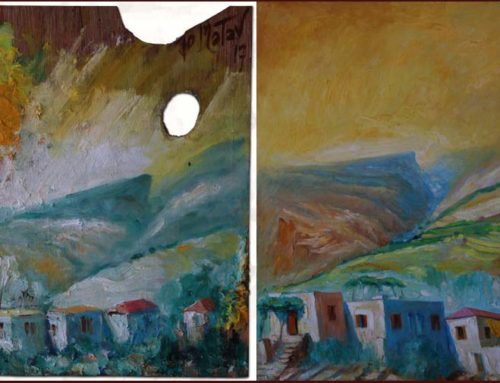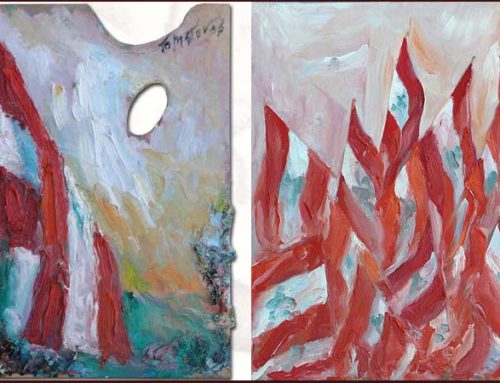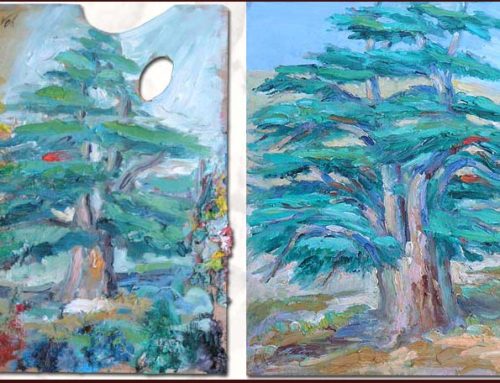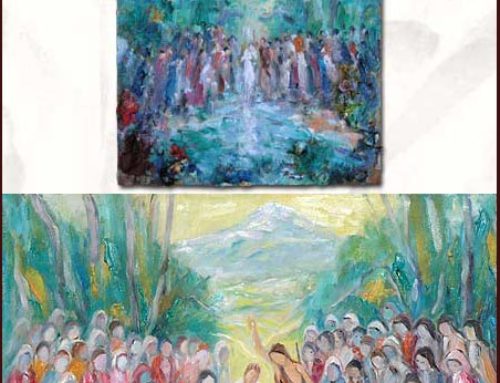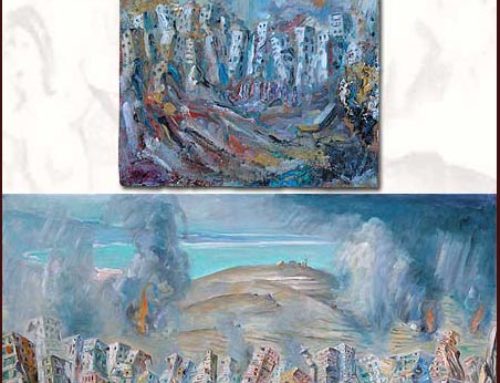Our Lady of El-Maysseh
It was a certain Holy Thursday, Thursday of the Mysteries, commemoration of that Thursday over two thousand years ago when Jesus of Galilee passed the lengthiest, most anguished, most excruciating night of his earthly existence. His suffering was so terrible that he sweated blood, while beside him his disciples slept. He was the only one awake and was demanding of his Heavenly Father that if it were His will the chalice of his Passion should be removed from him.
But at some little distance away there was another who was wide awake, one who was leading a troop of guards and evildoers to deliver to them his Master. In his belt there lay close-packed thirty pieces of silver, one piece of silver for every day of the month. Their color was that of the lamp of the night, the celestial body that has no light of its own but reflects the beams of the sun.
At Amsheet, not far from Byblos (Jbeil) there stand twenty-seven churches, each one dedicated to a different saint. At Byblos there is an even greater number, for each family used to have its own chapel or oratory, as ancient temples and sanctuaries were transformed into Christian places of worship after the Edict of Constantine.
Within the historic walls of the Phoenician city of Byblos there were seven churches built. In the very middle of this venerable site there stands the chapel of the Nakhleh family, an ancient edifice fifty feet long and twenty feet high, dedicated to Our Lady. Some call it Our Lady of “Celtis” and others call it Our Lady of Deliverance, but that is no problem, it is simply Our Lady’s.
At a bend in the road leading to it there are some trees, particularly some Seville orange trees, a small garden and an open square, which one reaches by going down three or four steps. Around are some old buildings imbued with an air of antiquity which has been furnished as an office of UNESCO. These may be reached either on foot or by car from any of the four points of the compass.
Like the walls of the citadel, the main building is composed of sandstone blocks and of various elements swept up after neighboring construction. In point of fact it is a vault for the mortal remains of the Nakhleh family. It was restored by the General Directorate of Antiquities and is in very good condition. The neighboring nuns assure public prayer there and teach the catechism to children. From time to time I used to ask one of my priest friends to come and celebrate Mass in the oratory.
More than once the Apostolic Nuncio came to celebrate the Eucharist, with no one present other than actual members of the Nakhleh family or guests whom they had invited, for the chapel is not a diocesan parish church. But in it a marriage and several baptisms have been performed.
On Holy Saturday, the faithful in Lebanon have a custom of visiting seven churches. Some say that the number seven has a mystical significance referring to the holy mysteries. Others would say that the Holy Virgin searched for her son Jesus in seven different places. This is one of the popular customs attributed to the West. Further, some keep vigil with Jesus in church until midnight, the supposed hour of Jesus’ arrest.
The mystical significance of the number seven comes to us from the Sumerians. Their wise men contemplated the seven heavenly bodies appearing to revolve round the earth and consecrated to each of these one day of the week; for the sun Sunday, for the moon Monday (Fr. lune – lundi), for Mars Tuesday (Fr. mardi), for Mercury Wednesday (Fr. mercredi), for Jupiter Thursday (Fr. jeudi), for Venus Friday (Fr. vendredi), and for Saturn Saturday (Fr. samedi).
It was the astronomer Herschel who in 1767 broke the magic charm by discovering the planet Uranus and then the mathematician Leverrier by calculating the existence of Neptune discovered in 1857. The first seven bodies were called the heavenly “eyes” (Zacharias 3: 9 and Tobias 15: 7). The Book of the Apocalypse in turn played around the number seven but also Saint Matthew used the tradition (1: 17) and Saint Luke (3: 33-38, seventy-seven names in eleven groups).
This particular Holy Thursday of April 17th, 2014, I decided to open the doors of this holy shrine of the Nakhleh family to the faithful from 8 o’clock in the morning till midnight and the departure of the last pilgrim. A priest came to depose the Blessed Sacrament. I spent the whole day there but was particularly attentive from 4 p.m. till 12 midnight. Numbers of the faithful came from Byblos itself, the region around and nearby villages, Jounieh, Batroun and even the capital Beirut, lighting candles and praying.
During the night of Holy Thursday these people did not go to sleep. During the early hours of the day the traffic was normal, with small groups coming to pray and meditate. But after four in the afternoon the flow of pilgrims was unbelievable. From outside not far from the door I watched a flood of humanity, a tide without end, like bees swarming in. The chapel, the square, the garden, the approaching roads, all were crammed for more than seven hours without interruption.
The priest in charge brought the Host, the Blessed Sacrament, at 5 o’clock, and exposed it over the altar, so the Body of Christ could be a link for the people with his Godhead.
The faithful came, knelt, lighted candles, and prayed with deep feeling, some kissing the ground, the door and the chapel floor. Many exclaimed at the beauty of the chapel and asked about the Masses said there. They asked why Mass was not said every day, how old the chapel was and to what saint or saints it was dedicated.
Some of the groups of faithful prayed aloud and sang canticles together. All were happy, with faces and expressions alight with joy because of their common faith and the beautiful religion they lived and practiced as one.
I was completely unconscious of the passing of time and felt no weariness although I was standing for eight hours at one stretch. I was simply happy, because of this grace that may be reached only by love of Jesus and our sublime convictions which we owe to our Christianity.
And what can be said about those famous pilgrimages in Europe, to Saint James of Compostella, Lourdes, Cassia, Assisi and Chartres? I recall Charles Péguy who undertook a pilgrimage of more than fifty miles to Our Lady of Chartres: “We have a favorable wind behind us all day and lie down in the evening, seeming close to home.”
Seated on a large stone near the window I watched with an enchantment all these good people who had come to my dear Byblos and its sanctuary to pray to the Good God. I was just glad to have thought of giving new life to this small shrine on such an exceptional day. I felt no inclination to leave when the Lord was my guest, present among us.
At midnight the monk from St. John’s came for the consecrated Host in order to put it back in the tabernacle of the parish church. But the faithful still came, young, old, children and adults. So I called on a man in charge of maintenance in the convent of the nearby nuns to remain in order to close the doors when everybody had finally left the chapel.
A monk came to say some prayers for the dead that their souls might rest in peace. He remarked to me that the souls of the faithful departed were in their eternal state also united to the Lord and that Holy Thursday was a special day when we should live a time of repentance for out sins.
Our Lady of Micocoulier (Supplement to 2016)
Seated at the back of the church this last Holy Thursday of the year 2016, I watched, listened, and meditated, lost in reverie, with many questions in my mind; for I was in a nostalgic mood, thinking of past times when our forebears lived in the region.
Little swarms of humanity penetrated this place of prayer, this ancient church with its simple architecture, redolent of human contact, with stones impregnated with memories.
Children came running joyfully in front of their parents, hurrying to light candles, while women went on their knees up to the altar with their rosary beads between their fingers or round their necks. Young and old, all came into this presence for sincere, warm and pious communion with Our Lord Jesus Christ, our Creator. All this was more than I ever expected.
Several elderly women were anxious to know more about the place and asked me if this had not been the church where Saint Rafca came to pray. Some vague information to this effect had been handed on to them by their mothers and fathers.
Yes, it was true. Around 1860, Holy Rafca, still under the name of Butressieh, spent two years teaching here in the school of the Sisters of the Holy Hearts across the road a few paces away from the church. This was the year when Ernest Renan was staying in Lebanon at Byblos; and before she went on to Maad the young Butressieh was teaching catechism, geography and arithmetic in the Sisters’ school separated from the church by only an alley. One has to use one’s imagination only a little to see the place as it was then while one enjoys the present calm so disposing to prayer. The surroundings have not changed overmuch.
The next day I went to the presbytery of Father Saadeh, who has written thousands of pages translated into several languages on the life of Saint Rafca. He confirmed what I had previously suspected. I was deeply moved to learn of the ties between ourselves and the saint who had been the guest of the family chapel.
I was touched, happy, and even proud to have come to pray in the very place where Saint Rafca herself had knelt to ask Jesus to help her in her suffering some years before she went to Byblos for treatment for her eyes. In fact she was to suffer yet more for the doctor tore out her eye, inflicting most cruel pain!
All this she supported in order to share with Christ his suffering. A painting Rafca at Prayer in the convent where she spent her last years reminds us of the event.
Joseph Matar
All rights reserved © LebanonArt
Translated from French: K. J. Mortimer



